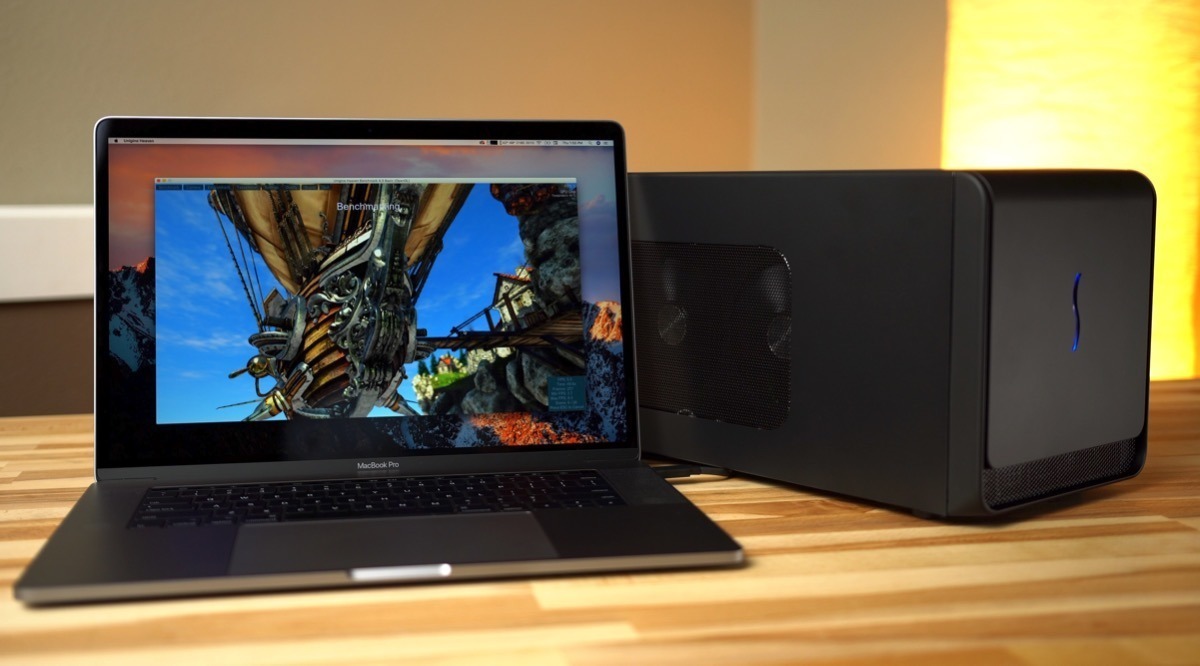The lack of support for external GPUs in Apple Silicon M1 Macs may only be temporary, as a connected eGPU is still detected, but doesn't do anything.
The introduction of the M1-equipped Macs, including the Mac mini, MacBook Air, and 13-inch MacBook Pro promoted the on-processor GPU, but signs indicated that support for eGPUs were on the way out. Developer support documentation and later experimentation confirmed that support for non-Apple GPUs wouldn't be enabled in hardware using Apple Silicon, effectively making eGPUs largely unusable.
However, testing by Mac4Ever corroborated by AppleInsider's own trials, offers hope to eGPU owners. While eGPUs are not officially supported by the latest M1 MacBook Air, MacBook Pro, and Mac mini, macOS 11 still sees the enclosure, and the PCI-E card inside.
In plugging a Pro Display XDR into a Blackmagic eGPU inserted into a Thunderbolt 3 port, it was found the eGPU enclosure was still detected and functions. The display communicates with the MacBook Pro as normal, complete with video playback.
Additionally, AppleInsider has seen the Razer Core X, and the Sonnet eGFX Breakaway Box identify itself properly to macOS with an assortment of cards, including the RX 590, Vega 64, and Radeon VII. However, monitors connected directly the cards do nothing.
![An M1 MacBook Pro detects the eGPU and the Pro Display XDR fine, but doesn't use GPU acceleration [via Mac4ever]](https://photos5.appleinsider.com/gallery/38966-74411-90989_les-mac-m1-gerent-les-ecrans-144hz-xl.jpg) An M1 MacBook Pro detects the eGPU and the Pro Display XDR fine, but doesn't use GPU acceleration [via Mac4ever]
An M1 MacBook Pro detects the eGPU and the Pro Display XDR fine, but doesn't use GPU acceleration [via Mac4ever]The Radeon 580 GPU included in the above enclosure isn't actively being used for graphics acceleration, nor are any of the cards we've been testing. A lack of drivers is the most obvious reason for the lack of support, but oddities in how Apple has implemented Thunderbolt or external PCI-E addressing may also be contributing factors.
This discovery leads to the possibility that Apple may reintroduce eGPU support in the future. It would have to arrive as an update to macOS Big Sur, a new M-series chip launch, or possibly both.
Apple's support for eGPUs came with a spring update to macOS Mojave — with a complete lack of support for Nvidia cards. The core technology functions properly in macOS Big Sur with an assortment of Intel Macs.
 Malcolm Owen
Malcolm Owen







-m.jpg)






 Christine McKee
Christine McKee

 Marko Zivkovic
Marko Zivkovic

 Andrew Orr
Andrew Orr
 Andrew O'Hara
Andrew O'Hara
 William Gallagher
William Gallagher



-m.jpg)


50 Comments
Interesting how first generation hardware features are assumed to be etched in stone and immutable. It couldn’t possibly be that Apple wanted to get these entry level machines in the hands of users as son as possible to gauge usage and performance No, no, assume the worst and start ranting and raving about how ALL ASi (current and future) Macs are useless pieces of garbage because these ENTRY LEVEL machines can’t run Windows natively and don't support eGPU. It’s happening on all the major Apple centric tech blogs.
I’m always ranting myself about how negativity and assuming the worst rules these forums. No room for positive thinking about the future of these machines and what the next generation might bring. Nope, the first ASi machines don't do this and don't support that so they are DOA.
My guess is that the TB spec provides a device enumeration scheme to identify all connected devices on the TB bus, whether or not they support graphics acceleration, and that GPU cards support a “pass through” mode to bypass the acceleration processing. There is likely some sort of handshake that needs to take place to allow the Mac and GPU to agree to use accelerated graphics processing, in addition to the cpu directing its video output to the GPU with the proper format and timing. Apple either hasn’t implemented this in M1 or hasn’t activated it. Hopefully the silicon has the required hardware and microcode and Apple can turn it on later. I’m not holding my breath but hope springs eternal.
My guess is that Apple may not plan to offer that to entry level machines or as mentioned not dealt with tat in M1 so may introduce it in M2 or 3 or my guess is if they are going to make own dedicated graphic chip then them may make own eGPU.
True can be that M2 can leap other low and midrange cards so and allowing eGPU could sink sale of remaining intel Macs that will be low anyway I guess.
Just ma 2 cents.
This is so hilarious. It means absolutely nothing. All TB and USB devices get detected if they are connected. It doesn't mean it's gonna do anything.